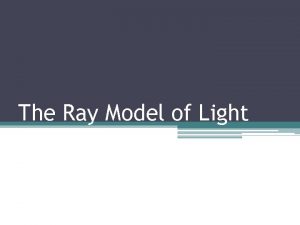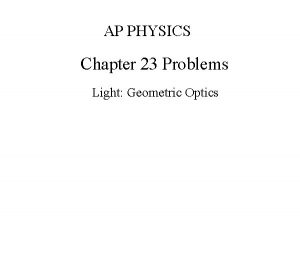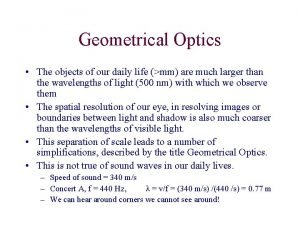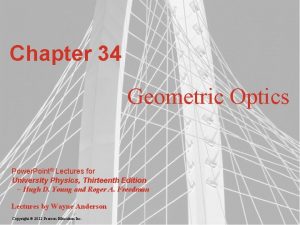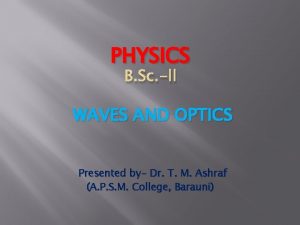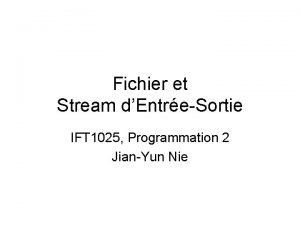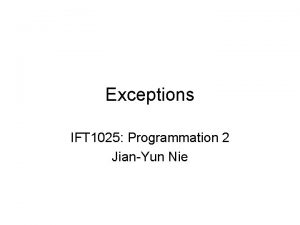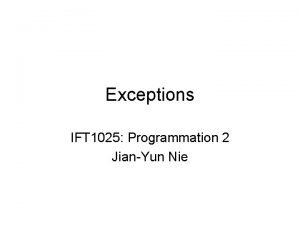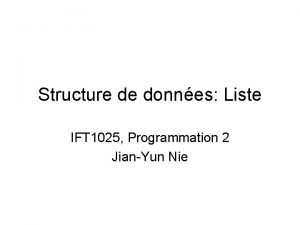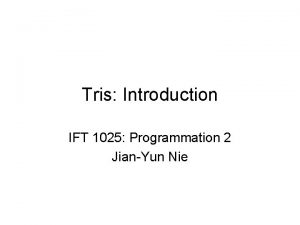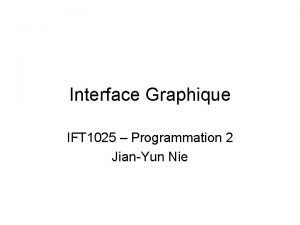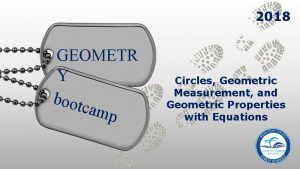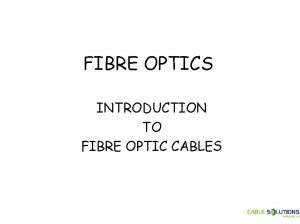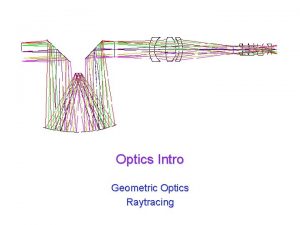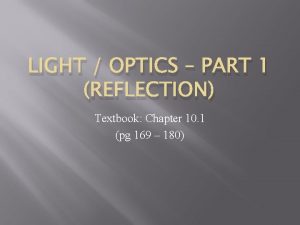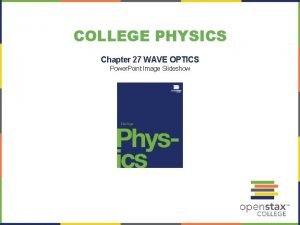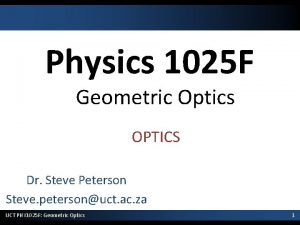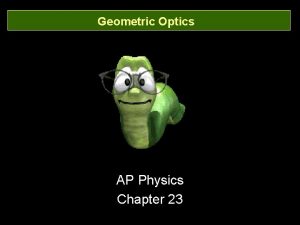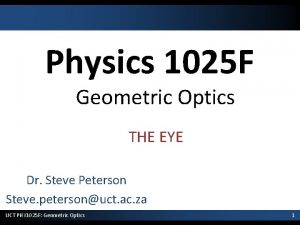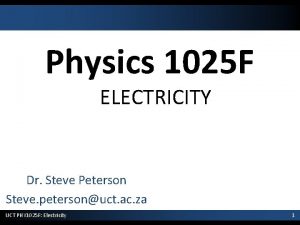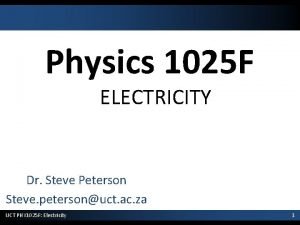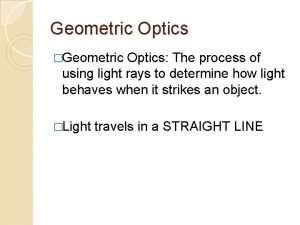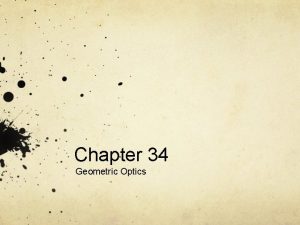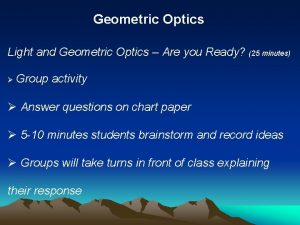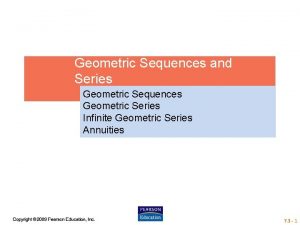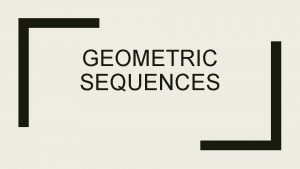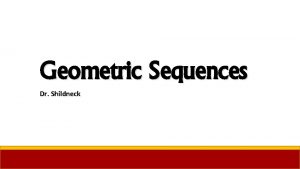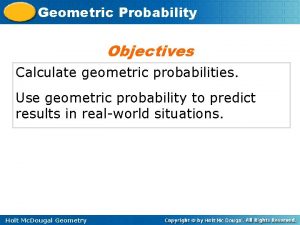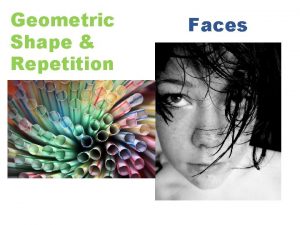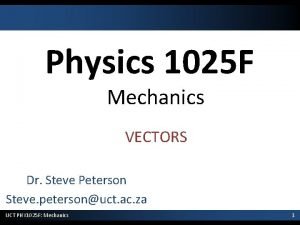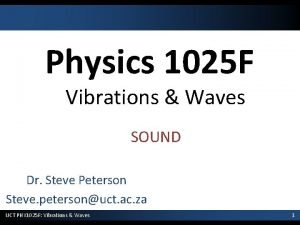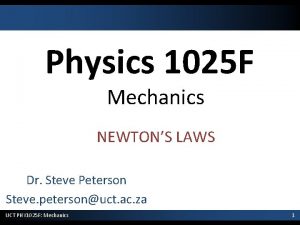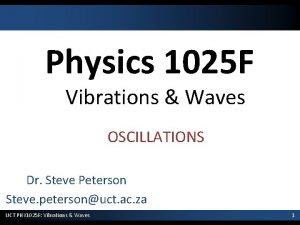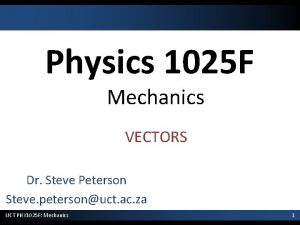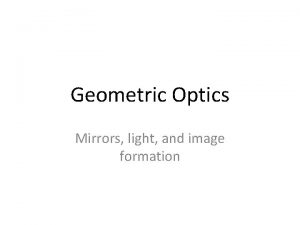Physics 1025 F Geometric Optics OPTICS Dr Steve

































- Slides: 33

Physics 1025 F Geometric Optics OPTICS Dr. Steve Peterson Steve. peterson@uct. ac. za UCT PHY 1025 F: Geometric Optics 1

Chapter 23: Geometric Optics In this section, we will use the ray model of light to understand the formation of images by mirrors and lenses through the processes of reflection and refraction. UCT PHY 1025 F: Geometric Optics 2

The Ray Model of Light rays appear to travel in straight lines. This assumption is the basis of geometric optics. The straight line paths that the light follows are called light "rays". A light ray is a line in the direction of the flow of radiant energy. UCT PHY 1025 F: Geometric Optics 3

Light: An Electromagnetic Wave In actual fact, light is an electromagnetic wave, as are radio, UV, infrared, gamma and micro-waves. An electromagnetic wave is composed of electric and magnetic waves which are perpendicular to each other, and to the direction of propagation. UCT PHY 1025 F: Geometric Optics 4

Electromagnetic Spectrum Electromagnetic waves can have any wavelength; there are different names given to different parts of the spectrum. The human eye only responds to EM waves in the wavelength range 400 - 700 nm, and we refer to these electromagnetic waves as "light". UCT PHY 1025 F: Geometric Optics 5

Light: An Electromagnetic Wave Maxwell calculated the speed of propagation of electromagnetic waves, he found: This is the speed of all electromagnetic waves (including light) in free space (vacuum). In gases, transparent liquids and solids light travels more slowly. UCT PHY 1025 F: Geometric Optics 6

Index of Refraction The index of refraction of a medium is the ratio of the speed of light in vacuum (c) to the speed of light in the medium (v): The index of refraction is never less than 1, and values for various materials are given in Table 23 -1. UCT PHY 1025 F: Geometric Optics 7

Reflection and Refraction When light encounters a boundary between two media the radiant energy can be: (i) reflected (ii) transmitted (iii) absorbed UCT PHY 1025 F: Geometric Optics 8

Laws of Reflection and Refraction 1. The incident, reflected and transmitted rays all reside in the same plane (the “plane of incidence”) which is normal to the plane of the interface. 2. The angle of incidence = angle of reflection. (ϴ 1 = ϴ 1’) 3. The angle of refraction (ϴ 2) and the angle of incidence (ϴ 1) are related by Snell's law. 4. Light rays are reversible. UCT PHY 1025 F: Geometric Optics 9

Law of Reflection Law of reflection: the angle of reflection (that the ray makes with the normal to a surface) equals the angle of incidence. UCT PHY 1025 F: Geometric Optics 10

Diffuse vs. Specular Reflection When light reflects from a rough surface, the law of reflection still holds, but the angle of incidence varies. This is called diffuse reflection. With diffuse reflection, your eye sees reflected light at all angles. With specular reflection (from a mirror), your eye must be in the correct position. UCT PHY 1025 F: Geometric Optics 11

Reflection at a Plane Mirror UCT PHY 1025 F: Geometric Optics 12

Image Formation by a Plane Mirror What you see when you look into a plane (flat) mirror is an image, which appears to be behind the mirror. This is called a virtual image, as the light does not go through it. Virtual images are formed: behind the mirror. Real images are formed: in front of the mirror. The distance of the image from the mirror is equal to the distance of the object from the mirror. UCT PHY 1025 F: Geometric Optics 13

Refraction When light passes from one transparent medium to another, the velocity of the transmitted light changes depending on the material properties (index of refraction). If the light enters at an angle, the light ray will be bent or refracted as it crosses the boundary between the mediums. UCT PHY 1025 F: Geometric Optics 14

Refraction: Snell’s Law From less dense to more dense, light bends towards the normal. From more dense to less dense, light bends away from the normal. UCT PHY 1025 F: Geometric Optics 15

Refraction at a Plane Surface • UCT PHY 1025 F: Geometric Optics 16

Total Internal Reflection • UCT PHY 1025 F: Geometric Optics 17

Total Internal Reflection • UCT PHY 1025 F: Geometric Optics 18

Application: Fiber Optics Total internal reflection is also the principle behind fiber optics. Light will be transmitted along the fiber even if it is not straight. An image can be formed using multiple small fibers. UCT PHY 1025 F: Geometric Optics 19

Thin Lenses Thin lenses have faces which are portions of a sphere. The two faces can be convex, concave or planar. The thickness of a thin lenses is small compared to their radius of curvature. They may be either converging / convex (a) or diverging / concave (b). UCT PHY 1025 F: Geometric Optics 20

Convex (Converging) Lens Rays parallel to the principle axis incident on a convex lens are focused at a single point, the “focal point“ (F). The distance from the focal point to the centre of the lens is referred to as the “focal length”. If parallel rays fall on the lens at an angle to the principle axis then they are focused at point Fa in the “focal plane” of the lens. UCT PHY 1025 F: Geometric Optics 21

Concave (Diverging) Lens For a concave lens, parallel rays that pass through the lens appear to diverge from a single point F, the focal point of the diverging lens. The focal point is that point where the diverging rays would converge if projected back. UCT PHY 1025 F: Geometric Optics 22

Power of a Lens Optometrists and ophthalmologists use the reciprocal of the focal length (in metres) to indicate the strength of a lens. The unit of power is the diopter D (which is actually m -1. ) UCT PHY 1025 F: Geometric Optics 23

Convex Lens: Ray Tracing We use ray diagrams to determine where an image will be. For thin lenses, we use three key rays, all of which begin on the object: 1. 2. 3. This ray comes in parallel to the axis and exits through the focal point. This ray comes in through the focal point and exits parallel to the axis. This ray goes through the center of the lens and is undeflected. UCT PHY 1025 F: Geometric Optics 24

Convex Lens: Thin Lens Equation Geometrically, we can derive an equation that relates the object distance (do), image distance (di), and focal length (f) of the mirror: UCT PHY 1025 F: Geometric Optics 25

Magnification We can also find the magnification (ratio of image height, hi to object height, ho). By convention we introduce a – sign. If m is positive, the image is upright. If m is negative, the image is inverted. UCT PHY 1025 F: Geometric Optics 26

Convex Lens: Ray Tracing We use ray diagrams to determine where an image will be. For thin lenses, we use three key rays, all of which begin on the object: 1. 2. 3. This ray comes in parallel to the axis and exits through the focal point. This ray comes in through the focal point and exits parallel to the axis. This ray goes through the center of the lens and is undeflected. UCT PHY 1025 F: Geometric Optics 27

Concave Lens: Ray Tracing We use the same basic three rays, all starting from the object, except: 1. 2. 3. This ray starts parallel to the axis, but and exits in line with the focal point in front of the lens. This ray travels toward the far focal point and exits parallel to the axis. This ray goes through the center of the lens and is undeflected. UCT PHY 1025 F: Geometric Optics 28

Sign Conventions f is positive for a convex/converging lens is negative for a concave/diverging lens do is positive for a real object is negative for a virtual object di is positive for a real image is negative for a virtual image UCT PHY 1025 F: Geometric Optics 29

Sign Conventions To decide whether an object or image is real or virtual: For real objects the rays arriving at the lens are diverging, For virtual objects the rays arriving at the lens are converging. For real images the rays leaving the lens are converging, For virtual images the rays leaving the lens are diverging. UCT PHY 1025 F: Geometric Optics 30

Sign Conventions: Alternative The sign convention rules: 1. The focal length is positive for converging lenses and negative for diverging. 2. The object distance is positive when the object is on the same side as the light entering the lens (not an issue except in compound systems); otherwise it is negative. 3. The image distance is positive if the image is on the opposite side from the light entering the lens; otherwise it is negative. 4. The height of the image is positive if the image is upright and negative otherwise. UCT PHY 1025 F: Geometric Optics 31

The Lensmaker’s Equation The Lensmaker's equation relates the focal length of a lens to the radii of curvature R 1 and R 2 of the two surfaces of the lens. where n 1 is the refractive index of the medium surrounding the lens, n 2 the refractive index of the lens, and R 1 and R 2 are the radii of curvature of the front and back surfaces, respectively. In order to apply this equation correctly to both convex and concave surfaces we must adopt the following sign convention for radii of curvature. R is positive for convex surfaces is negative for concave surfaces when viewed from outside the lens UCT PHY 1025 F: Geometric Optics 32

The Lensmaker’s Equation • This useful equation relates the radii of curvature of the two lens surfaces, and the index of refraction, to the focal length. UCT PHY 1025 F: Geometric Optics 33
 Venn diagram of geometric optics and physical optics
Venn diagram of geometric optics and physical optics Difference between ray optics and wave optics
Difference between ray optics and wave optics Physics 2
Physics 2 Clearly explain what is meant by the term geometric optics
Clearly explain what is meant by the term geometric optics Geometric optics problems
Geometric optics problems Geometric optics in real life
Geometric optics in real life Geometrical optics ppt
Geometrical optics ppt Wave optics b.sc physics
Wave optics b.sc physics Ift1025
Ift1025 Mit 1025
Mit 1025 Ift1025
Ift1025 Ift 1025
Ift 1025 Ift 1025
Ift 1025 Chemsheets 1017 answers
Chemsheets 1017 answers Ift 1025
Ift 1025 Ift 1025
Ift 1025 Ift 1025
Ift 1025 Chemsheets
Chemsheets 1025 ce
1025 ce Ift1025
Ift1025 Steve jobs steve wozniak ronald wayne
Steve jobs steve wozniak ronald wayne Circles geometric measurement and geometric properties
Circles geometric measurement and geometric properties University physics with modern physics fifteenth edition
University physics with modern physics fifteenth edition Example ib physics ia
Example ib physics ia Why does it happen
Why does it happen Optics
Optics Free space optics
Free space optics Introduction to fiber optics
Introduction to fiber optics What is optics
What is optics Fiber optics richard sanders
Fiber optics richard sanders Http //www.phys.hawaii.edu/ teb/optics/java/slitdiffr/
Http //www.phys.hawaii.edu/ teb/optics/java/slitdiffr/ Optics
Optics First light optics
First light optics Optics
Optics



